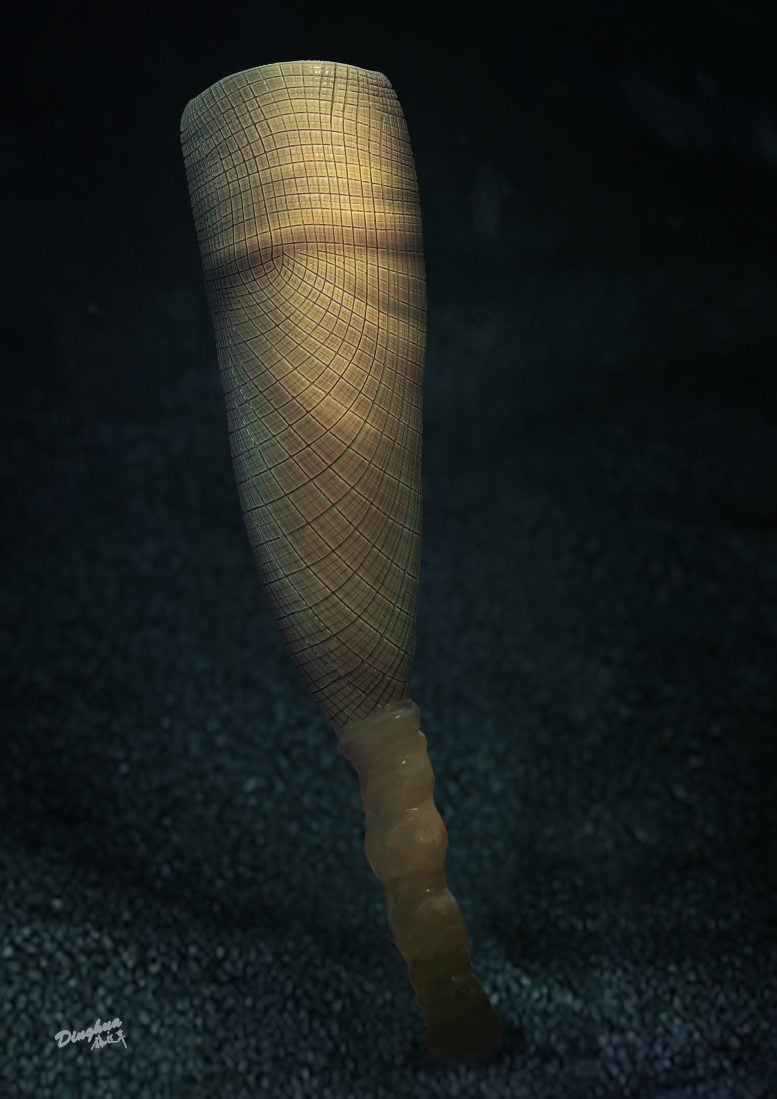
A groundbreaking discovery of a 550-million-year-old sea sponge fossil provides new insights into sponge evolution and guides future fossil research. Reconstructed life position of Helicolocellus in the Ediacaran sea floor. Credit: Yuan Xunlai
The research provides new insights into early animal evolution.
Researchers led by Shuhai Xiao at Virginia Tech have discovered a 550-million-year-old sea sponge fossil, shedding light on a 160-million-year-old gap in the fossil record. This fossil, which suggests that early sponges lacked mineral skeletons, provides new insights into the evolution of one of the earliest animals and influences how paleontologists search for ancient sponges.
At first glance, the simple sea sponge is not a mysterious creature. No brain. No guts. We have no problem dating it to 700 million years ago. However, convincing sponge fossils only go back to about 540 million years ago, leaving a gap of 160 million years in the fossil record.
In a letter published on June 5 in the journal NatureVirginia Tech geobiologist Shuhai Xiao and colleagues reported a 550-million-year-old sea sponge from the “lost years” and proposed that the earliest sea sponges had not yet developed mineral skeletons, providing new parameters for searching for lost fossils.
The mystery of the missing sea sponges centers on a paradox. Molecular clock estimates, which involve measuring the number of genetic mutations that accumulate over time, indicate that sponges must have evolved about 700 million years ago. And yet he had found no convincing sponge fossils in rocks that old.
For years, this conundrum was the subject of debate between zoologists and paleontologists.
This latest discovery completes the evolutionary family tree of one of the earliest animals, explaining its apparent absence in older rocks and connecting the dots to Darwin’s questions about when it evolved.
Xiao’s groundbreaking finding
Xiao, who was recently inducted into the National Academy of Sciences, first laid eyes on the fossil five years ago when a colleague texted him a photo of a specimen dug up along China’s Yangtze River. “I had never seen anything like this before,” said Xiao, a faculty member in the College of Science. “Almost immediately, I knew it was something new.”
Xiao and collaborators from the University of Cambridge and the Nanjing Institute of Geology and Paleontology began ruling out the possibilities one by one: not a sea squirt, not a sea anemone, not a coral. Could it be an ancient elusive sea sponge, they wondered?

Virginia Tech geobiologist Shuhai Xiao and colleagues reported a 550-million-year-old sea sponge fossil, filling a gap in the evolutionary family tree of one of the earliest animals. Photo by Spencer Coppage for Virginia Tech. Credit: Spencer Coppage for Virginia Tech
In a previous study published in 2019, Xiao and his team suggested that early sponges did not leave fossils because they had not evolved the ability to generate the strong needle-like structures, known as spicules, that characterize sea sponges today.
Members of Xiao’s team traced the evolution of the sponge through the fossil record. As they went further in time, the spicules of the sponge were increasingly organic in composition and less mineralized.
“If you extrapolate, then maybe the first ones were soft-bodied creatures with completely organic skeletons and no minerals at all,” Xiao said. “If that were true, they wouldn’t survive fossilization, except in very special circumstances where rapid fossilization outstripped degradation.”
Later, in 2019, Xiao’s international research group found a sponge fossil preserved in just such a setting: a thin bed of marine carbonate rocks known to preserve abundant soft-bodied animals, including some of the earliest mobile.
“Most often, this type of fossil is lost in the fossil record,” Xiao said. “New discovery provides a window into early animals before they developed hard parts.”
New fossil discovery and its implications
The surface of the new sponge fossil is filled with an intricate array of regular boxes, each divided into smaller, identical boxes.
“This specific pattern suggests that our fossilized sea sponge is more closely related to a particular one species made of glass sponge,” said Xiaopeng Wang, a postdoctoral researcher at the Nanjing Institute of Geology and Paleontology and the University of Cambridge.
Another surprising aspect of the new sponge fossil is its size. “When I was looking for fossils of early sponges, I expected them to be very small,” said Alex Liu, a collaborator from the University of Cambridge. “The new fossil is about 15 inches long with a relatively complex, conical body plan that challenged many of our expectations for early sponges.”
While the fossil fills in some of the missing years, it also provides researchers with important guidance on how to search for these fossils—which will hopefully expand understanding of early animal evolution further back in time.
“The discovery shows that maybe the first sponges were sponges but not glass,” Xiao said. “Now we know we have to broaden our view when looking for early sponges.”
Reference: “A late Ediacaran crown group sponge animal” by Xiaopeng Wang, Alexander G. Liu, Zhe Chen, Chengxi Wu, Yarong Liu, Bin Wan, Ke Pang, Chuanming Zhou, Xunlai Yuan, and Shuhai Xiao, June 5, 2024 , Nature.
DOI: 10.1038/s41586-024-07520-y
